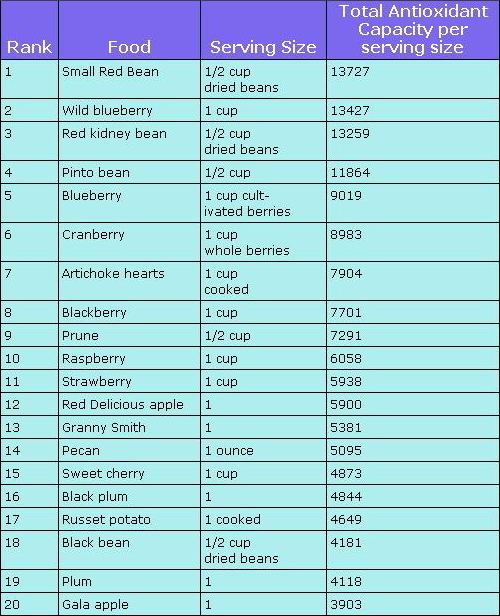Vitamin A (retinol), also synthesized by the body from beta-carotene, protects dark green, yellow and orange vegetables and fruits from solar radiation damage, and is thought to play a similar role in the human body. Carrots, squash, broccoli, sweet potatoes, tomatoes (which gain their color from the compound lycopene), kale, mangoes, oranges, seabuckthorn berries, wolfberries (goji), collards, cantaloupe, peaches and apricots are particularly rich sources of beta-carotene, the major provitamin A carotenoid.
Vitamin C (ascorbic acid) is a water-soluble compound that fulfills several roles in living systems. Important sources include citrus fruits (such as oranges, sweet lime, etc.), green peppers, broccoli, green leafy vegetables, black currants, strawberries, blueberries, seabuckthorn, raw cabbage and tomatoes.
Vitamin E, including tocotrienol and tocopherol, is fat soluble and protects lipids. Sources include wheat germ, seabuckthorn, nuts, seeds, whole grains, green leafy vegetables, kiwifruit, vegetable oil, and fish-liver oil. Alpha-tocopherol is the main form in which vitamin E is consumed. Recent studies showed that some tocotrienol isomers have significant anti-oxidant properties.
Vitamin cofactors and minerals
Coenzyme Q10
Manganese, particularly when in its +2 valence state as part of the enzyme called superoxide dismutase (SOD).
Iodide
Melatonin
Alpha-carotene - found in carrots, winter squash, tomatoes, green beans, cilantro, Swiss chard
Astaxanthin - found naturally in red algae and animals higher in the marine food chain. It is a red pigment familiarly recognized in crustacean shells and salmon flesh/roe.
Beta-carotene - found in high concentrations in butternut squash, carrots, orange bell peppers, pumpkins, kale, peaches, apricots, mango, turnip greens, broccoli, spinach, and sweet potatoes.
Canthaxanthin
Lutein - found in high concentration in spinach, kale, Swiss chard, collard greens, beet and mustard greens, endive, red pepper and okra
Lycopene - found in high concentration in cooked red tomato products like canned tomatoes, tomato sauce, tomato juice and garden cocktails, guava and watermelons.
Zeaxanthin - best sources are kale, collard greens, spinach, turnip greens, Swiss chard, mustard and beet greens, corn, and broccoli
Natural phenols are a class of molecules found in abundance in plants.
Flavonoids, a subset of polyphenol antioxidants, are present in many berries, as well as in coffee and tea.
Flavones:
Apigenin
Luteolin
Tangeritin
Flavonols:
Isorhamnetin
Kaempferol
Myricetin - walnuts are a rich source
Proanthocyanidins, or condensed tannins
Quercetin and related, such as rutin
Flavanones:
Eriodictyol
Hesperetin (metabolizes to hesperidin)
Naringenin (metabolized from naringin)
Flavanols and their polymers:
Catechin, gallocatechin and their corresponding gallate esters
Epicatechin, epigallocatechin and their corresponding gallate esters
Theaflavin its gallate esters
Thearubigins
Isoflavone phytoestrogens - found primarily in soy, peanuts, and other members of the Fabaceae family
Daidzein
Genistein
Glycitein
Stilbenoids:
Resveratrol - found in the skins of dark-colored grapes, and concentrated in red wine.
Pterostilbene - methoxylated analogue of resveratrol, abundant in Vaccinium berries
Anthocyanins
Cyanidin
Delphinidin
Malvidin
Pelargonidin
Peonidin
Petunidin
Chicoric acid - another caffeic acid derivative, is found in chicory and Echinacea.
Chlorogenic acid - found in high concentration in coffee (more concentrated in robusta than arabica beans), blueberries and tomatoes. Produced from esterification of caffeic acid.
Cinnamic acid and its derivatives, such as ferulic acid - found in seeds of plants such as in brown rice, whole wheat and oats, as well as in coffee, apple, artichoke, peanut, orange and pineapple.
Ellagic acid - found in high concentration in raspberry and strawberry, and in ester form in red wine tannins.
Ellagitannins - hydrolyzable tannin polymer formed when ellagic acid, a polyphenol monomer, esterifies and binds with the hydroxyl group of a polyol carbohydrate such as glucose.
Gallic acid - found in gallnuts, sumac, witch hazel, tea leaves, oak bark, and many other plants.
Gallotannins - hydrolyzable tannin polymer formed when gallic acid, a polyphenol monomer, esterifies and binds with the hydroxyl group of a polyol carbohydrate such as glucose.
Rosmarinic acid - found in high concentration in rosemary, oregano, lemon balm, sage, and marjoram.
Salicylic acid - found in most vegetables, fruits, and herbs; but most abundantly in the bark of willow trees, from where it was extracted for use in the early manufacture of aspirin.
Curcumin - Curcumin has low bioavailability, because, much of it is excreted through glucuronidation. However, bioavailability is substantially enhanced by solubilization in a lipid (oil or lecithin), heat, addition of piperine, or through nanoparticularization.
Flavonolignans - e.g. silymarin - a mixture of flavonolignans extracted from milk thistle.
Xanthones - mangosteen is purported to contain a large variety of xanthones, but some of the xanthones like mangostin might be present only in the inedible shell.
Eugenol
Capsaicin, the active component of chili peppers
Bilirubin, a breakdown product of blood, has been identified as a possible antioxidant.
Citric acid, oxalic acid, and phytic acid
N-Acetylcysteine, water-soluble
R-α-Lipoic acid, fat- and water-soluble
Uric acid, in humans, accounts for roughly half the antioxidant capacity of plasma. Fructose, which is found abundantly in fruits, significantly elevates uric acid levels in humans, and thus indirectly increases antioxidant capacity. High levels of uric acid may be a protective factor against Parkinson's disease and possibly other diseases related to oxidative stress.

